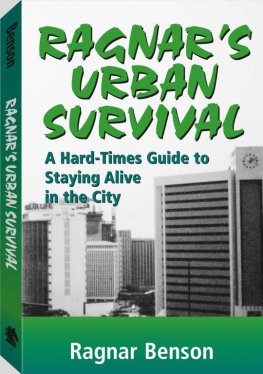A Down-to-Earth Approach to Beating the Government Gun Grab
RAGNAR BENSON
A Down-to-Earth Approach to Beating the Government Gun Grab
RAGNAR BENSON
PALADIN PRESS BOULDER, COLORADO
Also by Ragnar Benson
Acquiring New ID
Bulls-Eye: Crossbows
Do-It-Yourself Medicine
Eating Cheap
Hardcore Poaching
Live Off the Land in the City and Country
Man trapping
Modem Survival Retreat
The Most Dangerous Game: Advanced Mantrapping Techniques
Ragnars Action Encyclopedias, Volumes 1 and 2
Ragnars Guide to the Underground Economy
Ragnars Ten Best Traps ... And a Few Others That Are Damn Good, Too
Survival Poaching
Survivalists Medicine Chest
The Survival Retreat: A Total Plan for Retreat Defense
Switchblade: The Ace of Blades
Modern Weapons Caching:
A Down-to-Earth Approach to Beating the Government Gun Grab by Ragnar Benson
Copyright 1990 by Ragnar Benson
ISBN 0-87364-583-9
Printed in the United States of America
Published by Paladin Press, a division of
Paladin Enterprises, Inc., P.O. Box 1307, Boulder, Colorado 80306, USA.
(303) 443-7250
Direct inquiries and/or orders to the above address.
PALADIN, PALADIN PRESS, and the horse head design are trademarks belonging to Paladin Enterprises and registered in United States Patent and Trademark Office.
All rights reserved. Except for use in a review, no portion of this book may be reproduced in any form without the express written permission of the publisher.
Neither the author nor the publisher assumes any responsibility for the use or misuse of information contained in this book.
Visit our Web site at www.paladin-press.com
Contents
Introduction
Chapter One
The French Resistance
Chapter Two
Resistance Caching Strategy
Chapter Three
Vietnam: A Hard-Learned Lesson on Caching
Chapter Four
Caching and You
Chapter Five
Modern Caching Technology
Chapter Six
Caching vs. Hiding
Chapter Seven
Outsmarting the Enemy
Introduction
Weapons caching has been an important strategy in at least two of the major wars fought in the past fifty years.
Initially, it may seem strange to view weapons caching as having a significant impact on World War n, but in the case of occupied France from 1940 to 1944, the willingness and ability of the French Resistance to take delivery of weapons, move them around the country, and then safely store them against the day of need contributed in part to the defeat of the Nazis. Although the Resistance efforts were considered by many to be relatively puny (they used only three thousand pounds of C-4 for their entire operation, less than one goodsized bomb from a B-24 Liberator), they were more effective at sabotaging the Nazi war effort by stopping the production and flow of munitions than the entire bomber command, and inadvertent civilian casualties from Resistance activities were very light.
The Resistance organized very quickly after the occupation of France in June 1940. Because the French, like the English, had little history of private firearm ownership, there were few weapons on hand with which to commence action. (Historical records show that some farmers had shotguns, but virtually none owned pistols or rifles legally.) The first British agent into Paris radioed back that they had but two revolvers and two rifles. This appraisal may not have been entirely accurate, but it was the one accepted by the English.
Initially, only the French Communists were organized enough to carry out a credible program of opposition to the Germans. (Some historians downplay their role, but it was the Communists against the Fascists, and the United States supported the Communists.)
Some thirty years later, the United States lost in Vietnam, in part because of the elaborate, careful, weapons caches set up in patient, thorough, oriental fashion by the Vietnamese. Like the Resistance in World War n, the able, careful Vietcong made great use of weapons caches to defeat an opponent that thought itself smarter, better organized, and more technologically advanced.
Correlations between the Vietcong, who were Stalinist Communists, and members of the French Resistance, who were more Trotsky-like, are perhaps coincidental; at the very least the link is ironic. Nevertheless, like the French before them, burying weapons was, for the Vietnamese, a key tactical strategy. Each time they suffered reversal, their weapons went safely underground, beneath flooded rice paddies, or into the swamps.
Weapons caching technologies have changed dramatically since World War H. Methods of resealing containers and evacuating moisture have advanced to the point that technological problems are no longer a consideration. Caching difficulties with which the French Resistance labored mightily can be handled today without much thought as to what we would do without inexpensive plastic pipe, fittings, moisture-absorbing chemicals, and modem greases.
The Resistance had to work with heavy, clumsy, shiny aluminum tubing that cracked, corroded, leaked, and bent out of shape, creating almost insurmountable opening and reclosing problems. Modern plastic pipe and fittings found in plumbing supply shops alleviate these problems to a large extent. Like its aluminum predecessor, most plastic pipe is so tough it can be dropped out of a plane.
Because technologies related to locating a cache have also made quantum leaps, the person whose strategy includes weapons caching must now spend more time and energy deciding where to place a cache. This is in contrast to World War n, when the Resistance had to give as much thought to how the cache would be built as to where it would be placed.
Based upon the great emphasis some law enforcement people place on thoroughly searching a suspects home, yard, and grounds with sensitive electronic devices, official searchers and seekers appear to have identified weapons caching as a particularly threatening activity. These officials seem to have learned the lessons of history better than average citizens suspect.
Americans in Vietnam knew the Vietcong were getting weapons from irregular caches, and they learned that they needed to locate these caches whenever possible. Today many Americans realize the United States is in a race against firearms confiscation in which the lessons of the past will play a significant role. This book is dedicated to those who wish to look to the future with both mistrust and a will to prevail.
CHAPTER One
The French Resistance
We dont know Madeleines entire name. When she filed her story for the record in 1966, she still wished to maintain a great deal of anonymity. Now, twenty-five years after the writing, and forty-seven years after her incident, it is impossible to pinpoint exact dates or even last names.
In 1943, when she was first active in the French Resistance, she was but eighteen years old. In all likelihood, Madeleine was a Communist, but to what extent can a girl of eighteen be philosophically and religiously committed to communism? As events proved, she was very committed to a liberated France.
Her code name was Renee. She was with the area Resistance leader when he was shot dead by the Germans. Michel (his code name) made the mistake of bolting like a scared fox from the foot of a bridge they were about to blow up. He ran straight across the bridge, giving the guards a clear field of fire. Renee escaped unharmed through a thick, tangled hedge. The explosives they had intended to use came from a mine in northern France, where they were cached by another group whom Renee did not know. She was the only remaining member of her little central Paris band who knew the locations of the various weapons caches, as well as the identity of their parallel cells.
Next page








![Robert Hugh Benson [Benson - Robert Hugh Benson Collection [11 Books]](/uploads/posts/book/139831/thumbs/robert-hugh-benson-benson-robert-hugh-benson.jpg)



